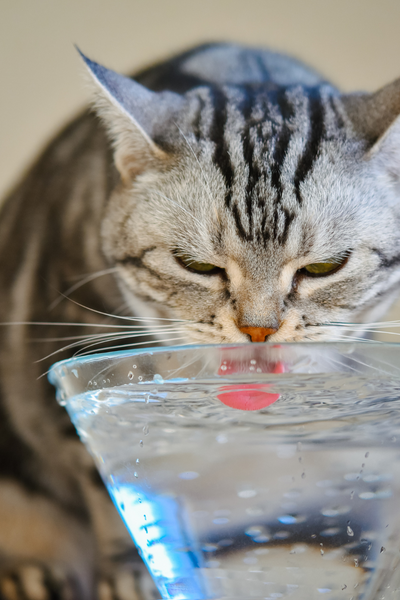
Water for Pets: How Much, and Tips for Keeping Pets Hydrated
Food is very important for a healthy pet, but you know what’s just as important? Water. And it’s super easy to provide! However, giving your pet water can sometimes be a little tricky – especially if you don’t know the answers to common questions.
So, in this article, we want to go over everything you need to know about giving keeping your pets hydrated.
How Much Water Do Pets Need?
Water is fairly intuitive, in that larger animals need more of it than smaller ones. For dogs, a rough guide is that they need to drink 1 ounce of water per pound of body weight. So, a twenty-pound dog needs to drink 20 ounces of water daily. In the case of cats, it’s 3.5-4.5 ounces per 5 pounds of body weight. So for a 10-pound cat, that’s 7-9 ounces of water every day.
For those of you that have more quirky pets, here’s a quick breakdown of how much water most pets need (per day):
- Hamsters: 10-30 ml
- Guinea pigs: 80-100 ml
- Rabbits: 100-150 ml per 2 pounds of body weight, or up to 300 ml for a 4-pound rabbit
- Birds: 5% of their body weight (just a couple gulps a day)
- Fish: All of it!
Is My Pet Drinking Enough Water?
The easiest way to determine whether your pet is drinking enough water is to monitor their water bowl. This works effectively if your pet is an indoor dog or cat, because then evaporation and other animals don’t factor in too much.
If, after a couple days, you notice your pet isn’t drinking enough water, it’s time to give them a hydration test.
To check whether your pet is dehydrated, you can gently pinch their skin. If the skin doesn’t snap right back to place when you release it, your pet may be dehydrated.
If they’re dehydrated, you need to take measures immediately for rehydration, which is a somewhat lengthy and complicated process. Make sure you follow a proper guide to ensure your pet is rehydrated correctly.
Warning signs of dehydration (in dogs) include:
- Loss of appetite
- Vomiting and diarrhea
- Low energy levels, lethargy
- Dry-looking eyes
- Panting
- Dry nose
- Dry, sticky gums
- Dehydration can be life-threatening if it goes unchecked, and even if your pet survives, it may cause permanent organ damage. So, work on preventing or treating dehydration asap!
Tips for Getting Your Pet to Drink More Water
Many pet owners have the same woe – their dog or cat simply won’t drink enough water. So, here, we’ve compiled some of our best tips to help you work more water into your pets’ diets.
1. Place water bowls around the house
It’s possible your pet doesn’t actually mind water, but they are simply too lazy or unmotivated to go in search of it when they aren’t super thirsty. So, get a couple different bowls (this will come in handy for our next tip), fill them up every morning, and place them strategically around the house, focusing on spots where your pet likes to hang out.
Dogs and cats don’t need a whole lot of water, but doing this may just encourage them to drink a little extra water, and therefore get to the required amount.
Using a lot of bowls means you’ll have a little more work on your hands, as you’ll need to empty them out and refill them daily, and wash them properly every week or so. However, if your pet’s drinking enough water and not having health issues, then the little bit of extra work is well worth it. As time passes, you may see that they prefer to drink in certain locations, and then you can cut back on the number of water bowls around the house.
2. Try out different bowls
Pets can be a little silly, and it’s wholly possible, especially with choosy or finicky pets, that they aren’t drinking enough water because they simply don’t like the water bowl! So, buy a couple different bowls made from different materials – plastic and metal of different kinds – and in different shapes, sizes and colors.
Place these bowls around the house to get two tricks for the price of one, and watch to see if your pet’s water intake goes up a little. Hopefully the increased number of bowls and the possibility of picking a favorite does the trick.
Sometimes, pets just don’t take to a particular bowl, or don’t like how it feels under their teeth.Or maybe it leaves a funny taste in the water. You can avoid these problems and try to troubleshoot it with this tip.
3. Flavor the water
You can try flavoring your pet’s water with fruit slices, fruit or vegetable juice, or a little low-sodium chicken broth. This will make the water tasty (which is a good trick for humans as well!) and entice your pet to drink more water. This works for most pets, as we all like a little treat. Just make sure, if flavoring the water, that you wash out their water bowl extra carefully.
It’s safe to flavor their water and allow them a mini-treat each time they go in to drink their water. If they are picky they may not want to drink their water without the flavoring, but chances are, once they develop the habit, you can slowly taper off the flavoring (if needed). Or if you want to keep continuing it to give them an extra little treat, that’s completely okay too!
One thing to keep in mind is that while it’s safe for your pet to drink a little bit of freshly-squeezed juice, don’t give them fruit or vegetable juice too often. Try to give it to them in small quantities, mixed in water. And avoid giving dogs grape juice, as it can be toxic!
4. Try water fountains!
This is a fun one. Your pup may enjoy drinking from a pet fountain, which keeps the water cool and fresh-tasting. It’s a little like playing with a sprinkler for them, so they get to have a little fun each time they go for a sip.
You can add cold water to it, as cool water is more palatable for humans and pets alike, and raise the fountain on a stand, to make it easier for bigger dogs to access. However, pet water fountains aren’t just for dogs – cats enjoy them too! You can get a cat water fountain online for as little as $20, and once it’s all set up, your cats should be super happy with it.
5. Give them wet food
If your pet really does not like drinking water, one possible solution is giving them wet food. It typically has 70-85% water, which makes it fairly water-rich and if your pet likes the wet food, they’ll consume a lot of water through it.
Ask your vet before you do this, however, as most vets suggest 25% wet food, but depending on your pet’s health and needs, this ratio may be different. Wet food usually contains more fat than dry food, for instance. So if your pup is prone to pancreatitis or certain other ailments, you may have to keep the ratio fairly low.
6. Give them a little ice
While ice isn’t the healthiest thing for your pet, it’s just water, so it isn’t exactly unhealthy either. This summer, you can try giving your pets a little ice. Kitties and doggos love the stuff, and they’ll play with it, lick it, and therefore drink lots of water before it melts down.
You can experiment with different shapes and sizes, such as a large bowl-sized chunk of ice, little ice chips, ice cubes, or ice balls. Whatever your pet likes best is the go-to. Cats may especially enjoy chasing ice cubes around and playing with them, as they behave a little like mice as they melt and scoot around the place.
Once they get used to drinking water and realize that it feels good, they’ll keep up the habit and it can carry over into the winter months, when you can’t give them ice.
So, these were some of our best tips for getting your pet to drink more water. Undoubtedly there are other little tips and hacks that might work – but these are tried-and-tested methods that usually get results. Give them a try, and soon enough your pet will be happily slurping up water!
Spring Naturals – Healthy Food for a Healthy Pet
In addition to drinking enough water, your pet needs to consume nutritious food every day to maintain good health, a glossy coat, and a stress-free mind.
Spring Naturals is your go-to brand for healthy protein, low-carb, low-glycemic pet food. It’s honest nutrition, formulated to give your pets a long, healthy and happy life. It is all-natural, made with real meat, no meal, no grains, and always with whole foods.
Our products contain no fillers, by-products or split protein, and your pet will love them. We offer a variety of food options such as chicken, lamb, salmon and turkey, so you can decide what meets your pet’s needs and preferences best.
Loaded with superfoods such as blueberries, quinoa, spinach and cranberries, our kibble is bursting with flavor. Your furry friends will love it!

Post a Comment!